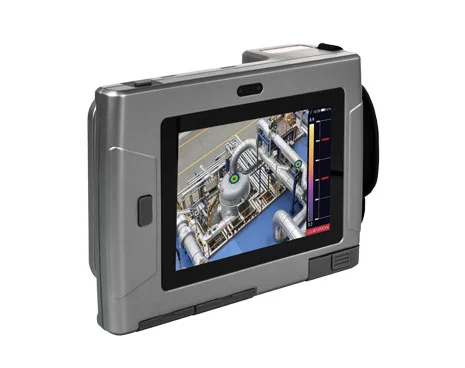Acoustic imaging camera devices are designed for a variety of applications, including gas leak detection, mechanical vibration monitoring, and the identification of partial discharge events. By integrating acoustic data with visual imagery, these devices allow users to effectively visualize dynamic sound sources on the display screen.

The operating principle of the acoustic imaging camera is primarily based on acoustic principles and advanced signal processing techniques. It receives sound waves emitted or reflected by objects and performs precise analysis and processing of these waves, allowing for the presentation of the location, intensity, and distribution of sound sources in image form. The acoustic imaging camera utilizes properties such as reflection, refraction, and scattering of sound waves as they propagate through different media. Through complex algorithms, it converts sound wave signals into intuitive images, facilitating non-contact, non-destructive testing and visual analysis of target objects.
Additionally, the system employs a microphone array to capture sound wave information from various sources. By utilizing beamforming and image recognition algorithms, it accurately overlays the positions of sound sources onto the visual imagery, enabling the visualization of sound source locations. This technology not only indicates where sounds originate but also reveals their characteristics, making sound visualization possible. With the acoustic imaging camera, it becomes feasible to "see" the locations and intensities of audible and ultrasonic sound sources.
The advantages of acoustic imaging camera primarily include high precision, non-contact measurement, visualization, multifunctionality, high sensitivity and strong penetration, rapid detection, cost savings, and safety and reliability.
High Precision
Acoustic imaging camera can accurately locate the position and direction of sound sources, detecting even minor sound emissions. This helps users quickly identify equipment faults or potential hazards.
Non-Contact Measurement
The device do not require contact with the measured object, preventing any interference or damage to the object being tested. This makes them suitable for inspecting sensitive or easily damaged items.
Visualization
Acoustic imaging presents sound fields in visual formats, allowing users to intuitively understand the distribution of sound fields and rapidly locate sound sources.
Multifunctionality
They can be used in various application scenarios, such as detecting equipment faults, monitoring environmental noise, and identifying sound sources.
High Sensitivity and Strong Penetration
Compared to traditional inspection methods, acoustic imaging camera offer greater sensitivity and penetration, enabling timely detection of surface defects and changes within equipment.
Rapid Detection
These instruments facilitate quick detection, allowing for comprehensive inspections of equipment in a short time frame, thus enhancing production efficiency.
Cost Savings
By using acoustic imaging instruments, businesses can avoid severe consequences like extensive power outages due to equipment failures, reducing maintenance costs and downtime.
Safety and Reliability
With remote detection capabilities, the device minimize disturbances and risks to both equipment and personnel, ensuring a safe and reliable inspection process.
Acoustic imaging camera has a wide range of applications across various industries, including but not limited to petrochemicals, metallurgy, power generation, machinery, automotive manufacturing, electronics, and research. Here are some specific examples of their use:
Machinery Manufacturing
In the machinery sector, acoustic imaging camera can be utilized to assess the acoustic quality of products, ensuring that they meet required specifications and standards.
Petrochemical Industry
In the petrochemical field, the device assists in detecting gas leaks at pipeline and valve interfaces, enhancing safety and operational efficiency.
Power Industry
In the power industry, acoustic imaging tools are invaluable for identifying partial discharge issues and mechanical faults in electrical facilities, contributing to preventive maintenance efforts.
Environmental Monitoring
Acoustic imaging camera is also effective in environmental monitoring, where it can locate and provide early warnings for abnormal noise levels, helping to address potential environmental concerns proactively.
